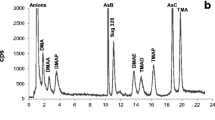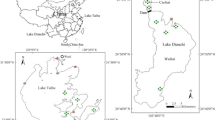Abstract
The various chemical forms of 74As accumulated from either water or food by the marine food chain [Fucus spiralis (L.)→ Littorina littoralis (L.)→Nucella lapillus] have been separated and characterized. Arsenic components were separated by differential extraction followed by high-voltage paper electrophoresis/paper chromatography of the water-soluble fraction and thin-layer chromatography of the lipid-soluble fraction. The algae assimilates arsenic mainly (60%) as one lipid-soluble compound with Rf=0.18, and 12 water-soluble organo-arsenic compounds as minor components. On the other hand, the snails, whether labelled from water or food, produce predominantly one major water-soluble organo-arsenic compound with Rf=0.66. This water-soluble arsenic compound was produced by the snails and not by intestinal microbes. Time-course studies on the relative proportions of labelled arsenic compounds in algal tissue indicate a transition from arsenate through water-soluble organo-arsenic components to a lipid-soluble arsenic compound. The water-soluble organo-arsenic compounds in the food chain studied were different from those previously found or proposed in marine organisms.
Similar content being viewed by others
Literature Cited
Andreae, M. O. and D. W. Klumpp: Biosynthesis and release of organoarsenic compounds by marine algae. Envir. Sci. Technol. 13, 738–741 (1979)
Cooney, R. V., R. O. Mumma and A. A. Benson: Arsonium-phospholipid in algae. Proc. natn. Acad. Sci. U.S.A. 75, 4262–4264 (1978)
Edmonds, J. S., K. A. Francesconi J. R. Cannon, C. L. Raston, B. W. Skelton and A. H. White: Isolation, crystal structure and synthesis of arsenobetaine, the arsenical constituent of the western rock lobster Panulirus longipes. Tetrahedron Lett. 18, 1543–1546 (1977)
Edwards, T., H. L. Merilees and B. C. McBride: Rapid sensitive method, for the separation and detection of arsenic compounds in biological systems. J. Chromat. 106, 210–212 (1975)
Irgolic, K. J., E. A. Woolson, R. A. Stockton, R. D. Newman, N. R. Bottino, R. A. Zingaro, P. C. Kearney, R. A. Pyles, S. Maeda, W. J. McShane and E. R. Cox: Characterization of arsenic compounds formed by Daphnia magna and Tetraselmis chuii from inorganic arsenate. Envir. Hlth Perspectives 19, 61–66 (1977)
Klumpp, D. W.: Arsenic accumulation in an estuarine food chain, 269 pp. Ph. D. thesis, University of London, London 1979
Klumpp, D. W.: Characteristics of arsenic accumulation by the seaweeds Fucus spiralis and Ascophyllum nodosum. Mar. Biol. 58, 257–264 (1980a)
Klumpp, D. W.: Accumulation of arsenic from water and food by Littorina littoralis and Nucella lapillus. Mar. Biol. 58, 265–274 (1980b)
Lunde, G.: The absorption and metabolism of arsenic in fish. Rep. technol. Res Norw. Fish Ind. 5 (12), 1–15 (1972a)
Lunde, G.: Analysis of arsenic and bromine in marine and terrestrial oils. J. Am. Oil Chem Soc. 49, 44–47 (1972b)
Lunde, G.: The synthesis of fat and water soluble arseno-organic compounds in marine and limnetic algae. Acta chem. scand. 27, 1586–1594 (1973)
Lunde, G.: Isolation of an organoarsenic compound present in cod liver. J. Sci. Fd Agric. 26, 1247–1255 (1975a)
Lunde, G.: A comparison of organoarsenic compounds from different marine organisms. J. Sci. Fd Agric. 26, 1257–1262 (1975b)
Lunde, G.: Occurrence and transformation of arsenic in the marine environment. Envir. Hlth. Perspectives 19 47–52 (1977)
McKenzie, H. A.: pH and buffers. In: Data for biochemical research, pp 475–508. Oxford: Clarendon Press 1969
Penrose, W. R.: Biosynthesis of organic arsenic compounds in brown trout (Salmo trutta). J. Fish. Res. Bd Can. 32, 2385–2390 (1975)
Penrose, W. R., H. B. Conacher, R. Black, J. C. Meranger, W. Miles, H. M. Cunningham and W. R. Squires: Implications of inorganic/organic interconversions on fluxes of arsenic in marine food webs. Envir. Hlth. Perspectives 19, 53–59 (1977)
Porter, E. K.: Arsenic and associated elements in plants and soils, 214 pp. Ph. D. thesis, University of London, London 1976
Schneider, W. C.: Phosphorus, compounds in animal tissues. III. A comparison of methods for the estimation of nucleic acids. J. biol. Chem. 164, p. 747 (1946)
Vaskovsky, V. E., O. D. Korotchenko, L. P. Kosheleva and V. S. Levin: Arsentic in the lipid extracts of marine invertebrates. Comp. Biochem. Physiol. 41, 777–784 (1972)
Woolson, E. A., A. R. Isensee and P. C. Kearney: Distribution and isolation of radioactivity from As74-arsenate and C14-methanearsonic acid in an aquatic ecosystem. Pestic. Biochem. Physiol. 6, 261–269 (1976)
Wrench, J., S. W. Fowler, and M. Y. Unlu: Arsenic metabolism in a marine food chain. Mar. Pollut. Bull. 10, 18–20 (1979)
Author information
Authors and Affiliations
Additional information
Communicated by G. F. Humphrey, Sydney
Rights and permissions
About this article
Cite this article
Klumpp, D.W., Peterson, P.J. Chemical characteristics of arsenic in a marine food chain. Mar. Biol. 62, 297–305 (1981). https://doi.org/10.1007/BF00397696
Accepted:
Issue Date:
DOI: https://doi.org/10.1007/BF00397696




